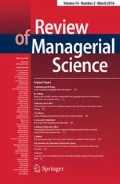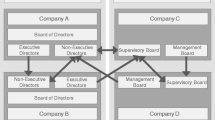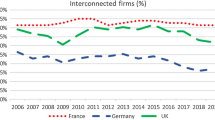Abstract
This study investigates how interlocking directorates affect dynamic corporate performance among 187 Taiwanese electronics companies during a 3 year sampling period (2013–2015). This study consists of two stages. First, this study measures the operational efficiency of electronics companies using the dynamic slacks-based measure model of data envelopment analysis. Second, this study adopts a truncated-regression model with bootstrap to examine the impacts of interlocking directorates on dynamic corporate performance. The empirical findings of this study indicate that centrality (direct connections), structural holes (indirect connections), and the number of connections (total connections) related to interlocking directorates have significant positive influences on the dynamic corporate performance of Taiwanese electronics companies. The results suggest that more interlocks at the board level leads to better corporate performance over a long-term period. Overall, this study uses social network analysis to shed light on the role of interlocking directorates and its importance to dynamic corporate performance from the resource dependence perspective.


Similar content being viewed by others
Notes
Carry-over refers to accounting items that are accumulated and carried forward from one period to another.
References
Ahuja G, Katila R (2004) Where do resources come from? The role of idiosyncratic situations. Strateg Manag J 25:887–907
Almodovar J, Teixeira AA (2014) Assessing the importance of local supporting organizations in the automotive industry: a hybrid dynamic framework of innovation networks. Eur Plan Stud 22:841–865
Bonacich P (1987) Power and centrality: a family of measures. Am J Sociol 92:1170–1182
Bourdieu P, Wacquant LJ (1992) An invitation to reflexive sociology. University of Chicago Press, Chicago
Bowlin W (1995) A characterization of the financial condition of the United States’ aerospace-defense industrial base. Omega 23:539–555
Burt RS (1993) The social structure of competition explorations in economic. Sociology 65:103
Burt RS, Knez M (1995) Kinds of third-party effects on trust rationality and society 7:255–292
Charnes A, Cooper WW, Rhodes E (1978) Measuring the efficiency of decision making units. Eur J Oper Res 2:429–444
Chiu Y-H, Luo Z, Chen Y-C, Wang Z, Tsai M-P (2013) A comparison of operating performance management between Taiwan banks and foreign banks based on the Meta-Hybrid DEA model. Econ Model 33:433–439
Cooper WW, Seiford LM, Tone K (2006) Introduction to data envelopment analysis and its uses: with DEA-solver software and references. Springer, New York
Cross RL, Thomas RJ (2008) Driving results through social networks: how top organizations leverage networks for performance and growth, vol 265. Wiley, New York
Fama EF, Jensen MC (1983) Separation of ownership and control. J Law Econ 26:301–325
Färe R, Grosskopf S, Norris M, Zhang Z (1994) Productivity growth, technical progress, and efficiency change in industrialized countries. Am Econ Rev 84:66–83
Ferris SP, Jagannathan M, Pritchard AC (2003) Too busy to mind the business? Monitoring by directors with multiple board appointments. J Finance 58:1087–1111
Freeman LC, Roeder D, Mulholland RR (1979) Centrality in social networks: II. Experimental results. Soc Netw 2:119–141
Gnyawali DR, Madhavan R (2001) Cooperative networks and competitive dynamics: a structural embeddedness perspective. Acad Manag Rev 26:431–445
Golany B, Roll Y (1989) An application procedure for DEA. Omega 17:237–250. https://doi.org/10.1016/0305-0483(89)90029-7
Gulati R, Nohria N, Zaheer A (2000) Strategic networks. Strateg Manag J 21:203–215
Horton J, Millo Y, Serafeim G (2012) Resources or power? Implications of social networks on compensation and firm performance. J Bus Finance Account 39:399–426
Jiraporn P, Kim YS, Davidson WN, Singh M (2006) Corporate governance, shareholder rights and firm diversification: an empirical analysis. J Bank Finance 30:947–963
Katz D, Kahn RL (1978) The social psychology of organizations, vol 2. Wiley, New York
Klopp G (1985) The analysis of the efficiency of productive systems with multiple inputs and outputs. Ph.D., University of Illinois at Chicago
Koka BR, Prescott JE (2002) Strategic alliances as social capital: a multidimensional view. Strateg Manag J 23:795–816
Li L, Tian G, Yan W (2013) The network of interlocking directorates and firm performance in transition economies: evidence from China. J Appl Bus Res 29:607–620
Liu Y, Lin WT, Cheng KY (2011) Family ownership and the international involvement of taiwan’s high-technology firms: the moderating effect of high-discretion organizational slack. Manag Organ Rev 7:201–222
Marsden PV (2002) Egocentric and sociocentric measures of network centrality. Soc Netw 24:407–422
Mizruchi MS (1996) What do interlocks do? An analysis, critique, and assessment of research on interlocking directorates. Ann Rev Sociol 22:271–298
Nicholson GJ, Alexander M, Kiel GC (2004) Defining the social capital of the board of directors: an exploratory study. J Manag Organ 10:54–72
Peng MW, Mutlu CC, Sauerwald S, Au KY, Wang DY (2015) Board interlocks and corporate performance among firms listed abroad. J Manag Hist 21:257–282
Pennings JM (1980) Interlocking directorates. Jossey-Bass Inc Pub, San Francisco
Powell WW, Koput KW, Smith-Doerr L (1996) Interorganizational collaboration and the locus of innovation: networks of learning in biotechnology. Adm Sci Q 41:116–145
Sacks MA, Ventresca MJ, Uzzi B (2001) Global institutions and networks: contingent change in the structure of world trade advantage, 1965–1980. Am Behav Sci 44:1579–1601
Shipilov AV, Li SX (2008) Can you have your cake and eat it too? Structural holes’ influence on status accumulation and market performance in collaborative networks. Adm Sci Q 53:73–108
Simar L, Wilson PW (2007) Estimation and inference in two-stage, semi-parametric models of production processes. J Econom 136:31–64
Surroca J, Tribó JA, Waddock S (2010) Corporate responsibility and financial performance: the role of intangible resources. Strateg Manag J 31:463–490
Tone K, Tsutsui M (2010) Dynamic DEA: a slacks-based measure approach. Omega 38:145–156
Tseng C-Y (2008) Internal R&D effort, external imported technology and economic value added: empirical study of Taiwan’s electronic industry. Appl Econ 40:1073–1082
Van Ees H, Postma TJ, Sterken E (2003) Board characteristics and corporate performance in the Netherlands. East Econ J 29:41–58
Wang W-K, Lu W-M, Kweh QL, Lai H-W (2014) Does corporate social responsibility influence the corporate performance of the US telecommunications industry? Telecommun Policy 38:580–591
Wong LHH, Gygax AF, Wang P (2015) Board interlocking network and the design of executive compensation packages. Soc Netw 41:85–100
Zaheer A, Bell GG (2005) Benefiting from network position: firm capabilities, structural holes, and performance. Strateg Manag J 26:809–825
Acknowledgements
Funding was provided by Ministry of Science and Technology, Taiwan (Grant No. 107-2410-H-606-005-MY3).
Author information
Authors and Affiliations
Corresponding author
Additional information
Publisher's Note
Springer Nature remains neutral with regard to jurisdictional claims in published maps and institutional affiliations.
Appendix
Appendix
1.1 Dynamic slacks-based measure of efficiency in DEA model approach
Assume that the dynamic process presented in Fig. 1 deals with \(n\) companies (\(j = 1, \ldots ,n\)) over \(T\) times (\(t = 1, \ldots ,T\)). During each time, companies have common \(m\) inputs (\(i = 1, \ldots ,m\)), \(s\) outputs (\(r = 1, \ldots ,s\)), and \(g\) carry-over items (\(h = 1, \ldots ,g\)). Let \(x_{ij}^{t} , \, y_{rj}^{t} ,\) and \(z_{hj}^{t}\) denote the input, output, and carry-over values of the jth company at time t, respectively. The DSBM model under variable returns to scale (VRS) evaluates the efficiency of the observed company by solving the following non-oriented fractional program:
where \(x_{io}^{t} , \, y_{ro}^{t} ,\) and \(z_{ho}^{t}\) are linked to \(x_{ij}^{t} , \, y_{rj}^{t} ,\) and \(\, z_{hj}^{t}\) by the intensity variable \(\lambda_{j}^{t}\). The restrictions of (2)–(6) make up the production possibility set, whereby (5) ensures that carry-over variables continue from t to t + 1, while (6) suggests the assumption of variable returns to scale. \(s_{it}^{ - } , \, s_{rt}^{ + } ,\) and \(s_{ht}^{c}\) are slack variables of input surplus, output gap, and carry-over gap, respectively. While the dividend is mean input efficiency, the divisor is the reversed mean output efficiency.
In line with Charnes et al. (1978), this study puts a scalar \(\delta \left( { > 0} \right)\) into the restrictions (1)–(6) to transform \(\left[ {\text{DSBM}} \right]\) into \(\left[ {\text{DSBMt}} \right]\), a nonlinear programming problem. Thus, we have the following equations:
where \(\delta s_{it}^{ - } , \, \delta s_{rt}^{ + } , { }\delta s_{ht}^{ + }\) and \(\delta \lambda_{j} \,\) are nonlinear, and \(\delta\) in the constraint (8) is adjusted to be 1. After defining \(S_{it}^{ - } = \delta s_{it}^{ - } , \, S_{rt}^{ + } = \delta s_{rt}^{ + } , \, S_{ht}^{c} = \delta s_{ht}^{c} \;{\text{and}}\;\Lambda _{j}^{t} = \delta \lambda_{j}^{t}\), \(\left[ {\text{DSBMt}} \right]\) becomes a linear program (LP) in \(\delta , \, S_{it}^{ - } , \, S_{rt}^{ + } , \, S_{ht}^{c} ,{\text{ and }}\varLambda_{j}^{t}\) as follows:
Let an optimal solution of \(\left[ {{\text{DSBMt}}\_{\text{LP}}} \right]\) be \(\left( {\tau_{o}^{*} , \, \delta^{*} , \, \varLambda_{j}^{t*} , \, S_{it}^{ - *} , \, S_{rt}^{ + *} , \, S_{ht}^{c*} } \right)\). Then, we have an optimal solution of \(\left[ {\text{DSBM}} \right]\) as defined by:
If the optimal solution for \(\left[ {\text{DSBMt}} \right]\) satisfies \(ATE_{o}^{*} = 1\) when there are no slacks, then the observed company is considered non-oriented overall efficient or, briefly, overall efficient:
If all optimal solutions of equation (21) satisfy \(TE_{o}^{t*} = 1\) when there are no slacks in term \(t\), then the observed company is considered non-oriented time efficient or, briefly, time efficient for time \(t\).
Rights and permissions
About this article
Cite this article
Wang, WK., Lu, WM., Kweh, Q.L. et al. Interlocking directorates and dynamic corporate performance: the roles of centrality, structural holes and number of connections in social networks. Rev Manag Sci 15, 437–457 (2021). https://doi.org/10.1007/s11846-019-00347-2
Received:
Accepted:
Published:
Issue Date:
DOI: https://doi.org/10.1007/s11846-019-00347-2
Keywords
- Social network
- Interlocking directorates
- Corporate performance
- Data envelopment analysis
- Dynamic slacks-based measure




